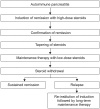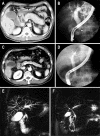Treatment and relapse of autoimmune pancreatitis
- PMID: 20485603
- PMCID: PMC2871571
- DOI: 10.5009/gnl.2008.2.1.1
Treatment and relapse of autoimmune pancreatitis
Abstract
Autoimmune pancreatitis (AIP) is a peculiar type of chronic pancreatitis whose pathogenesis involves autoimmune mechanisms. The steroid responsiveness has a significant impact on the diagnosis of AIP because patients with AIP and pancreatic cancer share many clinical features. This review focuses on the treatment and relapse of AIP. The goal of AIP treatment is remission of symptoms, serology, radiologic changes, or histology, which also applies to relapse. Although it is generally agreed that steroids should be offered to AIP patients with active disease, there is no standardized steroid regimen for AIP and no consensus on the dose and duration of steroid induction and tapering schedule, and optimal duration and dose of maintenance therapy. Obtaining a consensus on the optimal treatment regimen is very important to reducing the relapse rate. In this review, we discuss the treatment regimens used in many centers.
Keywords: Autoimmune pancreatitis; Relapse; Treatment.
Figures


Similar articles
-
Retrospective study of steroid therapy for patients with autoimmune pancreatitis in a Chinese population.World J Gastroenterol. 2013 Jan 28;19(4):569-74. doi: 10.3748/wjg.v19.i4.569. World J Gastroenterol. 2013. PMID: 23382638 Free PMC article.
-
Type 1 Autoimmune Pancreatitis in Europe: Clinical Profile and Response to Treatment.Clin Gastroenterol Hepatol. 2024 May;22(5):994-1004.e10. doi: 10.1016/j.cgh.2023.12.010. Epub 2024 Jan 5. Clin Gastroenterol Hepatol. 2024. PMID: 38184096
-
Is a 2-week steroid trial after initial negative investigation for malignancy useful in differentiating autoimmune pancreatitis from pancreatic cancer? A prospective outcome study.Gut. 2008 Dec;57(12):1704-12. doi: 10.1136/gut.2008.150979. Epub 2008 Jun 26. Gut. 2008. PMID: 18583399
-
Risk Factors for Rate of Relapse and Effects of Steroid Maintenance Therapy in Patients With Autoimmune Pancreatitis: Systematic Review and Meta-analysis.Clin Gastroenterol Hepatol. 2019 May;17(6):1061-1072.e8. doi: 10.1016/j.cgh.2018.09.051. Epub 2018 Oct 10. Clin Gastroenterol Hepatol. 2019. PMID: 30312787
-
Remission and relapse of autoimmune pancreatitis: focusing on corticosteroid treatment.Pancreas. 2010 Jul;39(5):555-60. doi: 10.1097/MPA.0b013e3181c8b4a5. Pancreas. 2010. PMID: 20182397 Review.
Cited by
-
Autoimmune Pancreatitis Associated With Progressive Giant Multilocular Pancreatic Pseudocyst and Steroid-Induced Diabetes.Cureus. 2024 Jul 19;16(7):e64946. doi: 10.7759/cureus.64946. eCollection 2024 Jul. Cureus. 2024. PMID: 39156470 Free PMC article.
-
Relapse of IgG4-related sclerosing cholangitis after steroid therapy: image findings and risk factors.Eur Radiol. 2014 May;24(5):1039-48. doi: 10.1007/s00330-014-3127-8. Epub 2014 Feb 28. Eur Radiol. 2014. PMID: 24573568
-
Newly developed autoimmune cholangitis without relapse of autoimmune pancreatitis after discontinuing prednisolone.World J Gastroenterol. 2012 Nov 7;18(41):5990-3. doi: 10.3748/wjg.v18.i41.5990. World J Gastroenterol. 2012. PMID: 23139619 Free PMC article.
-
Treatment of autoimmune pancreatitis with the anecdotes of the first report.Int J Rheumatol. 2012;2012:597643. doi: 10.1155/2012/597643. Epub 2012 Apr 3. Int J Rheumatol. 2012. PMID: 22548071 Free PMC article.
References
-
- Kim KP, Kim MH, Song MH, Lee SS, Seo DW, Lee SK. Autoimmune chronic pancreatitis. Am J Gastroenterol. 2004;99:1605–1616. - PubMed
-
- Kwon S, Kim MH, Choi EK. The diagnostic criteria for autoimmune chronic pancreatitis: it is time to make a consensus. Pancreas. 2007;34:279–286. - PubMed
-
- Chari ST, Murray JA. Autoimmune pancreatitis, Part II: the relapse. Gastroenterology. 2008;134:625–628. - PubMed
-
- Kamisawa T, Egawa N, Nakajima H, Tsuruta K, Okamoto A. Morphological changes after steroid therapy in autoimmune pancreatitis. Scand J Gastroenterol. 2004;39:1154–1158. - PubMed
-
- Song MH, Kim MH, Lee SK, et al. Regression of pancreatic fibrosis after steroid therapy in patients with autoimmune chronic pancreatitis. Pancreas. 2005;30:83–86. - PubMed
LinkOut - more resources
Full Text Sources
Miscellaneous

